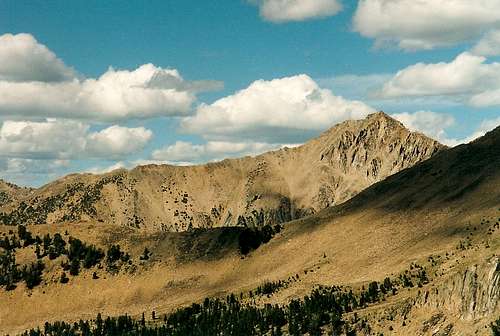-
 4846 Hits
4846 Hits
-
 77.48% Score
77.48% Score
-
 8 Votes
8 Votes
|
|
Route |
|---|---|
|
|
44.03010°N / 114.635°W |
|
|
Hiking, Scrambling |
|
|
Summer, Fall |
|
|
Half a day |
|
|
Class 2+ |
|
|
Overview
There is absolutely nothing wrong with the Northwest Ridge route already listed for this mountain. It is clear, simple, and direct, and it is also a little shorter than this one. But this route has two things going for it that the other doesn’t: a maintained trail for more than half the way; a stop by the shores of pretty Fourth of July Lake; and no bushwhacking, even though the NW Ridge bushwhack is a short one.
I recommend taking one of these routes up and the other down so that you can see more of the mountain and enjoy a little more of the beautiful White Clouds. The trail to Fourth of July Lake is a popular one, and though a crowd of the size you might find in the White Clouds would be considered sparse visitation in the Tetons, those who like their solitude may find it sorely lacking out here on a sunny summer Saturday or Sunday.
If you start early in the morning, take the NE Ridge up since the trail will be empty or at least very uncrowded then. If you go up in the late afternoon, use the NE Ridge for your descent to allow the trail to quiet down and clear out a bit while you are up above it.
Getting There
Follow the instructions given on the main page for this mountain. All I will add here is that driving south from Stanley, you will find the road for Fourth of July Creek about 10 miles south of the turnoff to popular Redfish Lake in the Sawtooths. You make a left on Fourth of July Road, which heads east.Route Description
The trailhead is at about 8800’. The hike to Fourth of July Lake, elevation 9365’, is about 1.5 miles. From the lake, it is about one mile and 1400 vertical feet to the summit. Total distance and elevation gain (approximately): 2.5 miles/1900’.
From the lake, the trail continues southeast to a pass at 9560’. At the pass, which overlooks upper Washington Basin, there is a tiny lake on the right side of the trail. Leave the trail here and start heading southwest up the loose ridge to the summit. There are no tricks or crux pitches here; just watch your footing. As you ascend, the incredible beauty of the White Clouds, largely unsung because of the famous Sawtooths nearby, throws itself at you. If you aren’t impressed by this scenery and filled with a longing to be atop all the amazing peaks you keep seeing, then perhaps nothing in the mountains can impress you and you need to find something else to do.
Click on the Topozone map for a clear representation of the NE ridge and the area’s topography.







